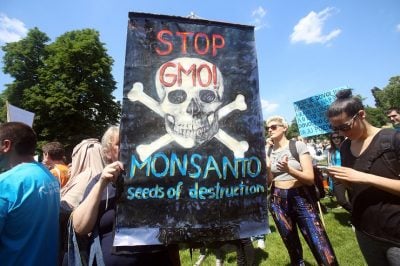The Dangers of Environmental Toxins

While California, Brazil and Bolivia have spent the past Northern Hemispheric summer burning and we all await more chaos created by more frequent natural disasters, a climate emergency of a different nature has gone under the radar for some time.
In fact, to even raise it as something that requires alarm or a sense of emergency seems to often be dismissed as conspiracy in spite of mounting evidence to the contrary.
Environmental toxins are wreaking havoc through our environment and while it’s cool to challenge our major polluters we ignore some of the other major corporations that are letting toxins go unchecked.
One of the most obvious and best culprits to challenge on this particular topic is Monsanto – one which many perceive as attracting perhaps unwarranted ire.
But yet, Monsanto were discovered in 2018 to have been ghost writing scientific studies only revealed when plaintiffs filed suits against the mega-corporation in an attempt to prove that glyphosate or Roundup was a carcinogen and in particular the result of their aggressive Non-Hodgkins Lymphoma. The court case also revealed that a prominent academic and proponent of GMO crops had asked Monsanto to draft an article for him which was identical to an article he had purportedly authored on Forbes.
Even further, one of the ‘BBC reporters’ at the trials was also later revealed to be a “reputation manager” for FTI consulting who’s clients include Monsanto. The results of the trial saw the plaintiffs walking away successfully with a jury satisfied that there is sufficient evidence that it is in fact a carcinogen.
The trial pushed open the door into a world that even the biggest tin-hatters could not have really imagined. Monsanto was revealed to have feelers and money spread all throughout industry and including scientific boards like the American Council on Health and Science, which purports to be independent of industry.
When the International Agency for Research on Cancer classified glysophate as a possible carcinogen in 2017, it was revealed that one of Monsanto’s PR firms had ‘contacts’ at Reuters who immediately published an article questioning the legitimacy of the IARC decision.
What’s most troubling about this of course is that the only study on Roundup since the EPA studies with fraudulent data implies that Monsanto has known since 1974 that their products are carcinogenic. In Australia, the agricultural chemical regulator, which receives funding from Monsanto, received pressure to review Roundup after the IARC decision but it refused despite a revelation in a Four Corners episode that they are in fact themselves funded by the agricultural industry.
Companies like Monsanto are a product of the post-WW2 blending of military and industry in the United States.
The military industrial complex sought to normalize the use of chemical weapons in warfare and the consequence of this was the rapid expansion of pesticide industries.
As Frank A Von Hippel reveals in his new book the Chemical Age, DDT an organic pollutant now primarily used for killing mosquitos is not just dangerous and harmful in that it negatively disrupts our hormones but that is has trans-generational epiginetic effects revealed after a study across Africa where it is used heavily. Organaphosphates were later developed as a purported replacement for DDTs as they were considered to able to degrade in the environment and detoxified by the human body several decades ago but this is now known to not be true.
The EPA banned them from being used in the home as late as 2001 because they were revealed to be disrupting developing brains and childrens nervous systems. However, pyrethroids and pyrethrins (a class of insecticide) continue to be used across suburbs, lawns and farmlands globally.
The EPA still considers this class safe for use despite a 2011 study of New York mothers which found that prenatal exposure to piperonyl butoxide — an additive commonly used in pyrethroid sprays — is strongly associated with delayed mental development in toddlers. The Transport Workers Union of Australia even in 2013 considered a class action suit for their airline workers over a link between Parkinsons Disease and insecticides used in long-haul flights since it is an Australian government measure that all flights are sprayed for insects before landing.
Hippel proposes that there is absolutely no square inch of Earth (including extremely remote tribes of the Antarctic, the upper layers of the atmosphere and in women’s breast milk) that insecticides and pesticides do not exist. And what’s more, there are a plethora of other herbicides have known impacts on human health.
Alex Jones is more infamously known for his theories around Atrazine but what we do know is that Atrazine is in fact an endocrine disruptor meaning that it can dysregulate hormones in the human body and any dysregulation of hormones necessarily leads to adverse health effect. And it is a herbicide found in many global populations water supply and was found in a Melbourne University study to be affecting men’s fertility.
Another better known endocrine disruptor is BPA found in most plastic which is most commonly linked to endometriosis or other forms of infertility in women but it can also act to suppress the production of testosterone in men. And if you think you are one of those people that can simply ‘go plastic-free’ I’m sure you’ll be surprised to learn that, that is quite impossible because it is literally everywhere.
Plastic is not just in your computer, your lunch box, your car or your phone, your clothes but more importantly in the form of microplastics covering the entirety of the Earth from sediments on the deep sea floor to ice in the Arctic.
Microplastics are said to poison the soil and in turn enter into our food supply.
And we know that microplastics are harming animals organs including their liver and bloodstream so its reasonable to guess that they are having at least a low grade negative effect on human health. The Lancet dubbed microplastics an “urgent human health problem” calling for strong regulations on plastic producers. And in fact, with so many endocrine disruptors now in the atmosphere and in every day items that we encounter its suspected to be at least partially linked to drastically declining fertility rates in men – declining by over 50% in the past 40 years. Which not only leaves men less healthy but the species in jeopardy of real decline.
Not only do insecticides and pesticides destroy human fertility but they also destroy long-term soil fertility too creating larger and larger chunks of the Earth that will not be arable in decades to come. But what’s damning right now is that GMO crop production methods are increasingly producing vegetables with higher and higher levels of lectins. If you are unfamiliar with lectins, it is a natural insecticide produced by some plants (a part of their natural defensive mechanisms) which high intake in humans is increasingly showing strong association with an array of chronic diseases from diabetes to fibromyalgia and association with damaged gut permeability.
Most vegetables have some level of lectins already but it’s inconsequential to most GMO Big Agra companies how high the level is that they are raising them to if it is a cheap and profitable guard for their crops.
It’s no coincidence of course that we don’t treat these issues with the same level of alarm that is afforded climate change, which of course deserves weight in its own right, but to ignore a holistic approach to environmental destruction leaves us not knowing the full array of people (or more accurately multinational corporations) to point fingers at. Because ultimately, the reason so many of us are hoodwinked into, in many cases, dismissing this aspect of environmental destruction as nothing but sheer conspiracy is exactly because of industry conspiracy to hide the real harm these producers in fact do.
The only difference is that they’ve somehow managed to wage a much better PR campaign than most coal producers. Most countries regulate these chemicals in different ways the UK has 50% less pesticides and insecticides in their foods than the US does for example but until in all countries we have determined that there are safe human levels (and exactly what that is) without corporate fraud and bullying, we may never know if there even is a safe level for human exposure. Whether it’s the insectides in your soft tissues, or the microplastics you are ingesting, we will never not feel the consequences of pollutant mega-corporations from the military industrial complex to Big Agra, and in the West we need to learn the confidence to teach them to pay a price for it.
*
Note to readers: please click the share buttons above or below. Forward this article to your email lists. Crosspost on your blog site, internet forums. etc.
Jemma Nott is a multimedia journalist.
Featured image is from Shutterstock


